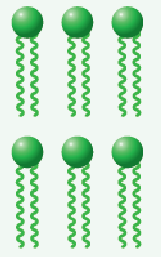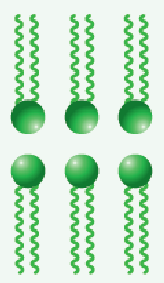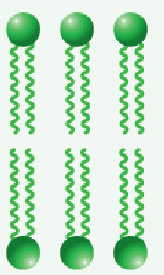
Organic And Biological Chemistry
7th Edition
ISBN: 9781305081079
Author: STOKER, H. Stephen (howard Stephen)
Publisher: Cengage Learning,
expand_more
expand_more
format_list_bulleted
Concept explainers
Textbook Question
Chapter 8.10, Problem 1QQ
Which of the following is a correct representation for the structure of a lipid bilayer?



- a. no correct response
Expert Solution & Answer
Trending nowThis is a popular solution!

Students have asked these similar questions
Some of the theories used to describe interface structure can be distinguished by:1. the measured potential difference.2. the distribution of ions in solution.3. the calculation of charge density.4. the external Helmoltz plane.
When talking about the acidity of carboxylic acids, is it the same thing to say higher or stronger acidity?
Using the following two half-reactions, determine the pH range in which $NO_2^-\ (aq)$ cannot be found as the predominant chemical species in water.* $NO_3^-(aq)+10H^+(aq)+8e^-\rightarrow NH_4^+(aq)+3H_2O(l),\ pE^{\circ}=14.88$* $NO_2^-(aq)+8H^+(aq)+6e^-\rightarrow NH_4^+(aq)+2H_2O(l),\ pE^{\circ}=15.08$
Chapter 8 Solutions
Organic And Biological Chemistry
Ch. 8.1 - Prob. 1QQCh. 8.1 - Which of the following is not a biochemical...Ch. 8.1 - The saponifiable/nonsaponifiable classification...Ch. 8.2 - Prob. 1QQCh. 8.2 - Prob. 2QQCh. 8.2 - Prob. 3QQCh. 8.2 - Prob. 4QQCh. 8.3 - Prob. 1QQCh. 8.3 - Prob. 2QQCh. 8.4 - How many structural subunits are present in the...
Ch. 8.4 - Prob. 2QQCh. 8.4 - Prob. 3QQCh. 8.4 - How many different mixed triglyceride molecules...Ch. 8.4 - Prob. 5QQCh. 8.4 - Unsaturated fatty acid residues are structural...Ch. 8.5 - Prob. 1QQCh. 8.5 - Prob. 2QQCh. 8.5 - Prob. 3QQCh. 8.6 - Prob. 1QQCh. 8.6 - Prob. 2QQCh. 8.6 - Prob. 3QQCh. 8.6 - Prob. 4QQCh. 8.6 - Prob. 5QQCh. 8.6 - Prob. 6QQCh. 8.7 - Based on biological function, phospholipids are...Ch. 8.7 - Prob. 2QQCh. 8.7 - Which of the following statements about the...Ch. 8.7 - When the head and two tails structural model is...Ch. 8.7 - Prob. 5QQCh. 8.7 - Prob. 6QQCh. 8.8 - The number of structural building blocks present...Ch. 8.8 - Prob. 2QQCh. 8.9 - Prob. 1QQCh. 8.9 - Which of the following types of membrane lipids...Ch. 8.9 - Prob. 3QQCh. 8.10 - Which of the following is a correct representation...Ch. 8.10 - Prob. 2QQCh. 8.10 - Prob. 3QQCh. 8.10 - Prob. 4QQCh. 8.10 - Which of the following membrane transport...Ch. 8.11 - Which of the following statements concerning bile...Ch. 8.11 - Which of the following statements concerning...Ch. 8.12 - Which of the following statements concerning...Ch. 8.12 - Prob. 2QQCh. 8.12 - Prob. 3QQCh. 8.13 - Prob. 1QQCh. 8.13 - Aspirin reduces inflammation and fever by...Ch. 8.13 - Prob. 3QQCh. 8.14 - Prob. 1QQCh. 8.14 - Prob. 2QQCh. 8.14 - Prob. 3QQCh. 8.15 - In which of the following pairs of lipid types are...Ch. 8.15 - Prob. 2QQCh. 8.15 - Prob. 3QQCh. 8 - Indicate whether each of the following general...Ch. 8 - Indicate whether each of the following general...Ch. 8 - Would you expect lipids to be soluble or insoluble...Ch. 8 - Would you expect lipids to be soluble or insoluble...Ch. 8 - What is the biochemical function category for each...Ch. 8 - What is the biochemical function category for each...Ch. 8 - Classify each of the following fatty acids as...Ch. 8 - Classify each of the following fatty acids as...Ch. 8 - Classify each of the following fatty acids as...Ch. 8 - Prob. 8.10EPCh. 8 - Prob. 8.11EPCh. 8 - Prob. 8.12EPCh. 8 - Prob. 8.13EPCh. 8 - Prob. 8.14EPCh. 8 - Classify each of the fatty acids in Problem 19-13...Ch. 8 - Prob. 8.16EPCh. 8 - Draw the condensed structural formula for the...Ch. 8 - Draw the condensed structural formula for the...Ch. 8 - Prob. 8.19EPCh. 8 - Prob. 8.20EPCh. 8 - What is the relationship between carbon chain...Ch. 8 - What is the relationship between degree of...Ch. 8 - What structural change is associated with the...Ch. 8 - Prob. 8.24EPCh. 8 - In each of the following pairs of fatty acids,...Ch. 8 - In each of the following pairs of fatty acids,...Ch. 8 - What are the four structural subunits that...Ch. 8 - Draw the general block diagram for a...Ch. 8 - Prob. 8.29EPCh. 8 - Determine the following for a triacylglycerol in...Ch. 8 - Draw the condensed structural formula of a...Ch. 8 - Draw the condensed structural formula of a...Ch. 8 - Draw block diagram structures for the four...Ch. 8 - Draw block diagram structures for the three...Ch. 8 - Identify, by common name, fatty acids present in...Ch. 8 - Identify, by common name, fatty acids present in...Ch. 8 - A mixture of triacylglycerol molecules contains...Ch. 8 - Prob. 8.38EPCh. 8 - For each of the triacylglycerol molecules in...Ch. 8 - Prob. 8.40EPCh. 8 - Prob. 8.41EPCh. 8 - Prob. 8.42EPCh. 8 - Prob. 8.43EPCh. 8 - Prob. 8.44EPCh. 8 - In a dietary context, classify each of the...Ch. 8 - In a dietary context, classify each of the...Ch. 8 - Prob. 8.47EPCh. 8 - Prob. 8.48EPCh. 8 - What are the general names for the products...Ch. 8 - What additional products are formed when a...Ch. 8 - Classify each of the reaction situations in...Ch. 8 - Prob. 8.52EPCh. 8 - Draw condensed structural formulas for all...Ch. 8 - Draw condensed structural formulas for all...Ch. 8 - Draw condensed structural formulas for all...Ch. 8 - Draw condensed structural formulas for all...Ch. 8 - Why can only unsaturated triacylglycerols undergo...Ch. 8 - Prob. 8.58EPCh. 8 - How many molecules of H2 will react with one...Ch. 8 - How many molecules of H2 will react with one...Ch. 8 - Prob. 8.61EPCh. 8 - Prob. 8.62EPCh. 8 - Prob. 8.63EPCh. 8 - Prob. 8.64EPCh. 8 - Prob. 8.65EPCh. 8 - Prob. 8.66EPCh. 8 - Prob. 8.67EPCh. 8 - Prob. 8.68EPCh. 8 - The following is a block diagram for a...Ch. 8 - Prob. 8.70EPCh. 8 - What structural subunits in the block diagram for...Ch. 8 - Prob. 8.72EPCh. 8 - Prob. 8.73EPCh. 8 - Prob. 8.74EPCh. 8 - Based on the head and two tails model for the...Ch. 8 - Prob. 8.76EPCh. 8 - Prob. 8.77EPCh. 8 - Prob. 8.78EPCh. 8 - Prob. 8.79EPCh. 8 - Prob. 8.80EPCh. 8 - Prob. 8.81EPCh. 8 - Prob. 8.82EPCh. 8 - Prob. 8.83EPCh. 8 - What portion or portions of the structure of a...Ch. 8 - Which of the terms triacylglycerol,...Ch. 8 - Prob. 8.86EPCh. 8 - Which of the terms triacylglycerol,...Ch. 8 - Which of the terms triacylglycerol,...Ch. 8 - Prob. 8.89EPCh. 8 - Prob. 8.90EPCh. 8 - Prob. 8.91EPCh. 8 - Prob. 8.92EPCh. 8 - Prob. 8.93EPCh. 8 - Prob. 8.94EPCh. 8 - Indicate whether each of the following statements...Ch. 8 - Prob. 8.96EPCh. 8 - Prob. 8.97EPCh. 8 - Prob. 8.98EPCh. 8 - Prob. 8.99EPCh. 8 - Prob. 8.100EPCh. 8 - In a dietary context, what is the difference...Ch. 8 - In a dietary context, how do HDL and LDL differ in...Ch. 8 - What is the general structural characteristic...Ch. 8 - What constitutes the two outside surfaces of a...Ch. 8 - Indicate whether each of the following statements...Ch. 8 - Indicate whether each of the following statements...Ch. 8 - What is the function of unsaturation in the...Ch. 8 - Prob. 8.108EPCh. 8 - Prob. 8.109EPCh. 8 - Prob. 8.110EPCh. 8 - Prob. 8.111EPCh. 8 - Prob. 8.112EPCh. 8 - Prob. 8.113EPCh. 8 - Prob. 8.114EPCh. 8 - Prob. 8.115EPCh. 8 - Prob. 8.116EPCh. 8 - Prob. 8.117EPCh. 8 - Prob. 8.118EPCh. 8 - Prob. 8.119EPCh. 8 - Indicate whether each of the following statements...Ch. 8 - Prob. 8.121EPCh. 8 - Prob. 8.122EPCh. 8 - Prob. 8.123EPCh. 8 - Prob. 8.124EPCh. 8 - What is the medium through which bile acids are...Ch. 8 - Prob. 8.126EPCh. 8 - Prob. 8.127EPCh. 8 - Prob. 8.128EPCh. 8 - Prob. 8.129EPCh. 8 - Classify each of the following as (1) an...Ch. 8 - Prob. 8.131EPCh. 8 - Prob. 8.132EPCh. 8 - Prob. 8.133EPCh. 8 - Prob. 8.134EPCh. 8 - Prob. 8.135EPCh. 8 - Prob. 8.136EPCh. 8 - Prob. 8.137EPCh. 8 - Prob. 8.138EPCh. 8 - Prob. 8.139EPCh. 8 - Prob. 8.140EPCh. 8 - What is the major structural difference between a...Ch. 8 - What is the major structural difference between a...Ch. 8 - What structural feature distinguishes a...Ch. 8 - What structural feature distinguishes a...Ch. 8 - Classify each of the following types of lipids as...Ch. 8 - Classify each of the following types of lipids as...Ch. 8 - Classify each of the following types of lipids as...Ch. 8 - Prob. 8.148EPCh. 8 - Prob. 8.149EPCh. 8 - Draw the condensed structural formula of a wax...Ch. 8 - Prob. 8.151EPCh. 8 - Biological waxes have a head and two tails...Ch. 8 - Prob. 8.153EPCh. 8 - Prob. 8.154EPCh. 8 - Prob. 8.155EPCh. 8 - Prob. 8.156EPCh. 8 - Prob. 8.157EPCh. 8 - Prob. 8.158EPCh. 8 - Prob. 8.159EPCh. 8 - Prob. 8.160EPCh. 8 - Prob. 8.161EPCh. 8 - Prob. 8.162EP
Knowledge Booster
Learn more about
Need a deep-dive on the concept behind this application? Look no further. Learn more about this topic, chemistry and related others by exploring similar questions and additional content below.Similar questions
- Indicate the formula of the product obtained by reacting methyl 5-chloro-5-oxopentanoate with 1 mole of 4-penten-1-ylmagnesium bromide.arrow_forwardIn the two chair conformations of glucose, the most stable is the one with all the OH groups in the equatorial position. Is this correct?arrow_forwardIndicate the formula of the product obtained by reacting D-Galactose with hydroxylamine.arrow_forward
- helparrow_forwardThe temperature on a sample of pure X held at 1.25 atm and -54. °C is increased until the sample boils. The temperature is then held constant and the pressure is decreased by 0.42 atm. On the phase diagram below draw a path that shows this set of changes. pressure (atm) 2 0 0 200 400 temperature (K) Xarrow_forwardQUESTION: Answer Question 5: 'Calculating standard error of regression' STEP 1 by filling in all the empty green boxes *The values are all provided in the photo attached*arrow_forward
arrow_back_ios
SEE MORE QUESTIONS
arrow_forward_ios
Recommended textbooks for you
 General, Organic, and Biological ChemistryChemistryISBN:9781285853918Author:H. Stephen StokerPublisher:Cengage Learning
General, Organic, and Biological ChemistryChemistryISBN:9781285853918Author:H. Stephen StokerPublisher:Cengage Learning Organic And Biological ChemistryChemistryISBN:9781305081079Author:STOKER, H. Stephen (howard Stephen)Publisher:Cengage Learning,
Organic And Biological ChemistryChemistryISBN:9781305081079Author:STOKER, H. Stephen (howard Stephen)Publisher:Cengage Learning,

General, Organic, and Biological Chemistry
Chemistry
ISBN:9781285853918
Author:H. Stephen Stoker
Publisher:Cengage Learning

Organic And Biological Chemistry
Chemistry
ISBN:9781305081079
Author:STOKER, H. Stephen (howard Stephen)
Publisher:Cengage Learning,
Biomolecules - Protein - Amino acids; Author: Tutorials Point (India) Ltd.;https://www.youtube.com/watch?v=ySNVPDHJ0ek;License: Standard YouTube License, CC-BY